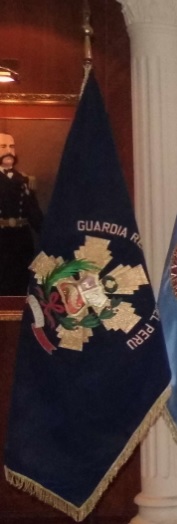 image located by
Esteban Rivera, 15 November 2017
image located by
Esteban Rivera, 15 November 2017
Last modified: 2025-01-11 by daniel rentería
Keywords: dircote | anti-terrorism directorate | dove | scales | sun (rising) | direccion | policia nacional del peru |
Links: FOTW homepage |
search |
disclaimer and copyright |
write us |
mirrors
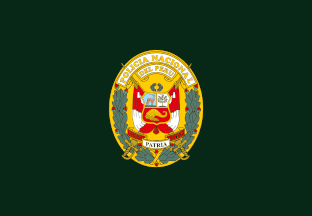 image by Zoltán Horváth, 28 August 2024
image by Zoltán Horváth, 28 August 2024The Peruvian Police is organized into several directorates.
Esteban Rivera, 15 Feb 2006
The Policia Nacional del Perú, PNP (Peruvian National Police) was formed on
December 6, 1988 through the merger of the
Guardia
Republicana del Perú (Peruvian Republican Guard, 1852-1988), the
Guardia Civil del
Perú (Peruvian Civil Guard, 1873-1988) and the
Policía de Investigaciones del Perú (Peruvian Investigation Police,
1922-1988). The PNP is controlled by the Ministerio del Interior (Interior
Ministry).
The PNP is currently organized into 25 Direcciones (Directorates), each one
having its own flag:
- Dirección Antidrogas (DIRANDRO, Anti-narcotics Directorate) (official
website)
- Dirección Contra el Terrorismo (DIRCOTE, Anti-Terrorism
Directorate) (official
website)
- Dirección de Investigación Criminal (DIRINCRI, Criminal Investigations
Directorate) (official
website)
- Dirección de Telemática (DIRTEL, Telematic Directorate) (official
website)
- Dirección de Aviación Policial (DIRAVPOL, Police Aviation Directorate) (official
website)
- Dirección de Seguridad (DIRSEG, Safety Directorate) (official
website)
- Dirección contra la Corrupción (DIRCOCOR, Anti-Corruption Directorate) (official
website)
- Dirección de Protección de Carreteras (DIRPRCAR, Road Protection Directorate)
(official
website)
- Dirección de Criminalística (DIRCRI, Criminalistics Directorate) (official
website)
- Dirección de Seguridad de Fronteras (DIRSEGFRO, Border Security Directorate) (official
website)
- Dirección de Turismo y Protección del Medio Ambiente (DIRTUPRAMB, Tourism and
Environmental Protection Directorate) (official
website)
- Dirección de Policía Fiscal (DIRPOFIS, Fiscal Police Directorate) (official
website)
- Dirección de Operaciones Especiales (DIROES, Special Operations Directorate) (official
website)
- Dirección de Educiación y Doctrina (DIREDUD, Education and Doctrine
Directorate) (official
website)
- Dirección de Comunicación e Imágen (DIRCIMA, Communication and Image
Directorate) (official
website)
- Dirección de Familia, Participación y Seguridad Ciudadana (DIRFAPASEC, Family,
Participation and Civil Security Directorate) (official
website)
- Dirección de Salud (DIRSAL, Health Directorate) (official
website)
- Dirección de Economía y Finanzas (DIRECFIN, Economy and Finance Directorate) (official
website)
- Dirección de Logística (DIRLOG, Logistics Directorate) (official
website)
- Dirección de Bienestar (DIRBIE, Welfare Directorate) (official
website)
- Dirección de Recuros Humanos (DIRREHUM, Human Resources Directorate) (official
website)
- Dirección de Pensiones (DIRPEN, Pensions Directorate) (official
website)
- Dirección de Seguridad Aeroportuaria (DIRSEAER, Airport Safety Directorate) (official
website)
- Dirección de Inteligencia (DIRIN, Intelligence Directorate) (official
website)
- Dirección de Seguridad de Penales (DIRSEPEN, Jail Security Directorate) (official
website)
Sources: http://www.pnp.gob.pe/ and
http://en.wikipedia.org/wiki/National_Police_of_Peru
The flag is a black (or maybe dark green) horizontal flag, featuring the
Coat of Arms
in the middle, which displays the motto "Dios, Patria, Ley" (God, Fatherland,
Law) and below the
Coat of Arms
reads DIRECCIÓN GENERAL in golden capital letters, as seen
here. (Source:
http://www.generaccion.com/noticia/133208/oscar-valdes-nuevo-presidente-consejo-ministros).
The Coat of
Arms explanation can be found
here.
For additional information go to:
PNP (official website)
Esteban Rivera, 18 November 2012
Its flag is dark green with its badge in the center of the flag.
Zoltán Horváth, 28 August 2024
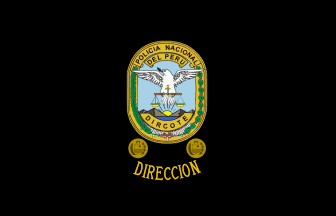 image by Eugene Ipavec, 15 Feb 2006
image by Eugene Ipavec, 15 Feb 2006
External links:
DIRCOTE (Dirección Contral el Terrorismo, or Directorate
Against Terrorism in English) is a Directorate within the Peruvian Police
force in charge of fighting terrorism in that country. It emerged in 1983
as the result of government measures to stop increasing terrorist activities
(mainly from guerrilla groups, but also form
paramilitary groups as well). The first name was Dirección Regional
Contra el Terrorismo, then it changed its name to Dirección
Nacional Contra el Terrorismo (DINCOTE) and it is finally called
Dirección Contra el Terrorismo, as it is known today.
Esteban Rivera, 15 Feb 2006
The flag is the coat of arms on a black background, plus two
Peruvian Coats of Arms (one on the right and
one on the left, in golden outline), plus the word "DIRECCION" below
the Peruvian Coats of Arms.
Esteban Rivera, 15 Feb 2006
Guardia Republicana del Perú, GRP (English: Peruvian Republican Guard)"
traces its origins as far back as the Article 165 of the 1823 Constitution,
sanctioned by the Congreso Constituyente (English: Constituent Congress) on
November 12, which stated that "the land forces are: Army Line, Civic Militia
and Police Guard. The Civic Militia will serve as safeguard of public security
and the Police Guard will safeguard private security". Then, there was the
establishment of the "Gendarmería" (English: Gendarmerie), by Decreto Supremo
(English: Supreme Decree) on April 14, 1852, creating the first Battalions on
April 7, 1856, as "Batallón de Gendarmería No. 1" and No. 2 (also known as "Regimiento
de Gendarmes No. 1" and No. 2) (English: Gendarmerie Battalion No. 1 and 2, also
known as "Gendarme Regiment No. 1" and No. 2). Its direct predecessor is
Battalion No. 1, composed of Infantry and Cavalry forces, which was also known
as "Batallón de Gendarmes de Infantería N° 1" (English: Infantry Gendarme
Batallion No. 1) and changed its name to Batallón de Gendarmes de Infantería
"Guardia Republicana del Perú" No. 1 (English: "Infantry Gendarme Batallion
'Republican Guard' No. 1) on August 7, 1919. It later changed its name
ca.1920-1930's to "Regimiento de Gendarmes de Infantería "Guardia Republicana
del Perú N° 1" (English: Infantry Gendarme Batallion 'Peruvian Republican
Guard' No. 1).
The first attempt at merging the Republican Guard and the
Civil Guard was in 1931, when they merged into the "2° Regimiento de Infantería
del Cuerpo de Seguridad de la República" (English: 2nd Infantry Regiment of the
Republic's Security Corp), later established on December 8, 1931 as "Guardia
Republicana del Perú" (English: Peruvian Republican Guard). In 1932, they are
separated again, and it gets back its flag and adopts its motto: "HONOR,
LEALTAD, DISCIPLINA" (English: Honor, Loyalty, Discipline).
Through Ley
N° 8072 (Law No. 8072) of March 23, 1935, the Guard's role was expanded to
patrolling the land frontiers, security of prisons, security of private and
public places of national importance, and to assist in maintaining peace and
order and national security as a whole, as well as contributing to the efforts
of the Armed Forces during wartime.
By
Ley N° 24294 (Law No. 24294) of September 14, 1985, the whole reorganization of
the existing Police forces is amended. The Republican Guard was amended through
Decreto Legislativo 372 (English: Legislative Decree 372) of February 4, 1986
changed its name to "Policía de Seguridad" (English: Security Police) until
1991.
The GRP is currently part of the Police.
Sources:
http://www.guardiarepublicana.com,
https://es.wikipedia.org and
https://en.wikipedia.org/wiki/Republican_Guard_(Peru)
 image located by
Esteban Rivera, 15 November 2017
image located by
Esteban Rivera, 15 November 2017
Its flag is a horizontal dark blue flag, with the emblem (https://i.ytimg.com/vi/Nsjg71TiYEk/hqdefault.jpg)
in the middle, and the motto, "HONOR, LEALTAD, DISCIPLINA" (English: Honor,
Loyalty, Discipline) in golden capital letters, surrounded by a golden fringe.
Image cropped from the original image:
http://adogenperu.org/actividades/banderas.jpg,
source:
http://adogenperu.org/actividades.html#actividad3).
For additional
information go to Guardia Republicana del Perú (official website):
http://www.guardiarepublicana.com
Esteban Rivera, 154 November
2017
The Guardia Civil (del Perú), GCP (more formally "Benemérita Guardia Civil
del Perú, BGCP)" (English: (Peruvian) Civil Guard, more formally "Worthy
Peruvian Civil Guard) traces its origins as far back as the Article 165 of the
1823 Constitution, sanctioned by the Congreso Constituyente (English:
Constituent Congress) on November 12, which stated that "the land forces are:
Army Line, Civic Militia and Police Guard. The Civic Militia will serve as
safeguard of public security and the Police Guard will safeguard private
security". The Civil Guard was formally established through Decreto Supremo
(English: Supreme Decree) of December 31, 1873. On Article 14 it reads:
"La Fuerza Regular de Policía se divide en dos Clases: Guardia Civil y Gendarmería
(la ultima a caballo y con labor de Policía Rural)."
(Article 14 of Chapter IV
reads: "The Regular Police Force is divided into two classes: the Civil Guard
and Gendarmerie (the latter on horseback and duties of Rural Police)"
The
first attempt at merging the Republican Guard and the Civil Guard was in 1931,
when they merged into the "2° Regimiento de Infantería del Cuerpo de Seguridad
de la República" (English: 2nd Infantry Regiment of the Republic's Security
Corp), later established on December 8, 1931 as "Guardia Republicana del Perú"
(English: Peruvian Republican Guard).
On January 5, 1944 the "Cuerpo de
la Guardia Civil" (English: Civil Guard Corp) and Cuerpo de Seguridad (English:
"Security Corp") were merged into one single entity called "Guardia Civil"
(English: Civil Guard).
Through Law No. 15605 of 1965 the Civil Guard is
granted the title "Benemérita" (English: Worthy).
By Ley N° 24294 (Law
No. 24294) of September 14, 1985, the whole reorganization of the existing
Police forces is amended. The Civil Guard was amended through Decreto
Legislativo 373 (English: Legislative Decree 373) of February 4, 1986. The GCP
is currently part of the Police.
Sources:
http://www.guardiarepublicana.com, ,
https://es.wikipedia.org and
https://en.wikipedia.org/wiki/Civil_Guard_(Peru)
 image located by
Esteban Rivera, 15 November 2017
image located by
Esteban Rivera, 15 November 2017
Its flag is a horizontal dark green flag, with the name of the organization
on top, "BENEMÉRITA", below "GUARDIA CIVIL DEL PERÚ", below its coat of arms (https://commons.wikimedia.org/wiki/File:PERUCIVILGUARD-COATOFARMS.jpg)
(approved by Resolución Ministerial (English: Ministry Resolution) of December
29, 1966.emblem) in the middle, and the motto, "EL HONOR ES SU DIVISA" (English:
Honor is its emblem) below, all in golden capital letters, surrounded by a
golden fringe.
Image cropped from the original image:
http://adogenperu.org/actividades/banderas.jpg,
source).
For additional information go to Benemérita Guardia Civil del Perú (official
website):
http://www.benemeritaguardiacivildelperu.com
Esteban Rivera, 15
November 2017
The "Policía de Investigaciones del Perú, PIP (English: Peruvian
Investigation Police) was the Corps of Detectives and Investigation Auxiliaries
(i.e. Civil Police or Secret Police) whose tasks were to investigate crimes,
public officials protection and justice. It was established on October 12, 1922
as "Brigada de Investigación y Vigilancia" (English: Investigation and
Surveilance Brigade). On August 26, 1929 it is transformed into the Cuerpo de
Investigación y Vigilancia, CIV (English: Investigation and Surveilance Corp).
On June 3, 1960 it changed its name to Policía de Investigaciones del Perú
(English: Peruvian Investigation Police).
On May 1981, the "Grupo
Especial Operativo" (English: Special Operative Group), within the "División de
Seguridad del Estado" (English: State Security Division) is established, which
is the genesis of what would later be the División de Policía Antisubversiva,
DIPAS (English: Antisubversive Police Division), which would be the cornerstone
of the DIRCOTE.
By Ley N° 24294 (Law No. 24294) of September 14, 1985,
the whole reorganization of the existing Police forces is amended. The
Republican Guard was amended through Decreto Legislativo 372 (English:
Legislative Decree 372) of February 4, 1986 changed its name to "Policía Ténica"
(English: Technical Police) until 1992.
The PIP is currently part of the
Police.
Sources:
http://www.guardiarepublicana.com and
https://es.wikipedia.org
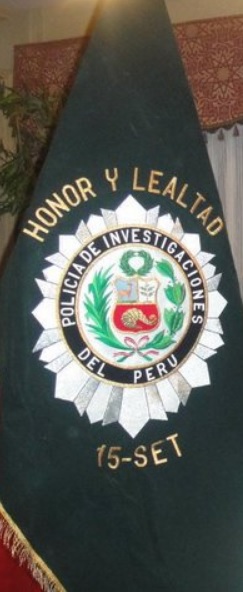 image located by
Esteban Rivera, 15 November 2017
image located by
Esteban Rivera, 15 November 2017
Its flag is a horizontal dark green flag, with the motto of the organization
on top, "HONOR Y LEALTAD" (English: Honor and Loyalty) in golden capital
letters, below the emblem (https://botw-pd.s3.amazonaws.com)
and below the date 15-SET (September 15 below, all in golden capital letters,
surrounded by a golden fringe.
Image cropped from the original image:
http://3.bp.blogspot.com,
source).
Esteban Rivera, 15 November 2017
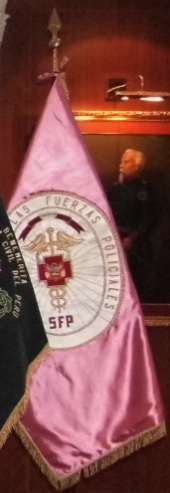 image located by
Esteban Rivera, 15 November 2017
image located by
Esteban Rivera, 15 November 2017
One of the Directorates of the Peruvian National Police is the "Dirección de
Salud (DIRSAL, Health Directorate)", more informally "Sanidad de las Fuerzas
Policiales, SFP" (English: Police Forces Sanitation).
Its flag is a pink
horizontal flag with the emblem in the middle, with an inscription around the
emblem that reads on top "SANIDAD DE LAS FUERZAS POLICIALES" and on the bottom
its initials, SFP, all in golden capital letters.
Image cropped image
from the original:
http://adogenperu.org/actividades/banderas.jpg, source:
http://adogenperu.org/actividades.html#actividad3.
Esteban Rivera, 15 November 2017